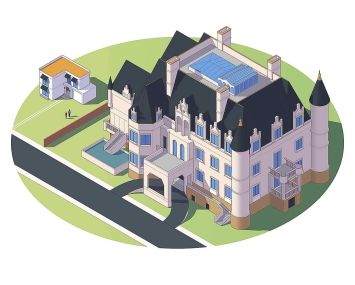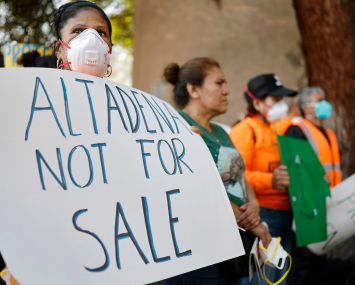‘Climate Havens’ Like Buffalo Lean Into Infrastructure and Policy
Their resiliency in the face of global warming isn’t just about the colder climate
By Anna Staropoli February 7, 2024 12:30 pm
reprints
Snowy winters, saucy chicken wings and football fanaticism don’t exactly conjure images of an idyllic “climate haven.” Buffalo, N.Y., however, has embraced its geographic and social characteristics — including those love-them-or-hate-them winters — to join other predominantly Northeast and Upper Midwest cities advertising as climate refuges.
Cities in these regions have branded their respective environments with opportunities for resilience, testing both the power and responsibility of development, commercial real estate and infrastructure.
Buffalo, specifically, has declared itself one of the safest American cities from natural disasters. Fellow climate havens include Ann Arbor, Mich.; Duluth, Minn.; Madison, Wis.; and Burlington, Vt., among others. These labels have been both self-imposed and recognized by external climate experts. The New York Times likewise highlighted the Northern Great Plains region as a safer area in the face of climate change.
The idea of climate havens has taken off as people wake up to the reality of climate change, said Ryan McPherson, chief sustainability officer at the University at Buffalo. However, he bristles at the “haven” or “refuge” label.
“I don’t think there’s any such thing as a climate haven,” said McPherson. “Sometimes, people are like, ‘Where can we go where we can get away from [climate disasters]?’ And ‘nowhere’ is the answer.”
Given the widespread devastation of global warming — even in seemingly safe places — skepticism has accompanied the rise of climate havens. Like the rest of the globe, Buffalo just recorded one of its warmest Decembers. It likewise experienced the smoky skies from last summer’s Canadian wildfires, as did fellow so-called havens in the inner Northeast and Upper Midwest. These regions also face seasonal threats of extreme snowfall — several feet at a time in Buffalo’s case — as well as flooding from heavy rain, like the storms that swept over Vermont, a supposed hub of climate havens, in July.
“Is there climate impact [in Buffalo]?” asked Brendan Mehaffy, executive director of the Office of Strategic Planning for the city. “Yes. But is it as severe as other places, nationally and globally? No.”
While the nature of a given city’s natural disasters predisposes it to certain climatic risks, the environment doesn’t hold all of the power. Rather, real estate, development and infrastructure still have a job to do, even — and perhaps especially — in cities self-defining as havens. Buffalo may leverage its climate, but it’s the city’s development and infrastructure that not only protect communities from disasters but also make them worth moving to — and staying in.
There are two components to a climate haven: supporting current residents and acting as a refuge for newcomers, said Kelley St. John, climate action manager for the City of Buffalo within the Mayor’s Office of Strategic Planning.
Climate havens have attracted new residents, who flee the hazards of their homes and subsequently seek an environment with more stability. Buffalo, for instance, drew a significant Puerto Rican community in the wake of 2017’s Hurricane Maria. People have also moved to Western New York from California and Texas, said Mehaffy, who cited conversations with newer residents who left California after years of wildfires. According to Advan Research, New York, California and Pennsylvania were the top three states from which Buffalo drew new residents in 2020.
Newcomers, however, don’t necessarily identify as climate refugees, said Mehaffy. Instead, he urges people not to get caught up in the label of “refuge” or “haven”; the phrase evokes a dramatic mass exodus when, in reality, it’s a trickle of people influenced by climate concerns, he said. The 2020 census showed Buffalo’s first rise in population in 70 years, though the numbers have since dwindled slightly. With a population of about 277,000, Buffalo remains New York’s second most populous city.
People — as well as businesses — crave security, predictability and stabilization, said McPherson. “These [climate issues] are real effects that are just like other trends that we’ve seen that push people into different places,” he said.
Granted, climate refugees exhibit not only the desire and drive to relocate but, often, also the means and resources. The climate haven trend therefore has complex implications for both the residents already in a given city and those who move.
Protecting current residents is priority No. 1, said McPherson, who believes the economy has to evolve to serve more people more adequately. This dual function of climate havens exposes the importance of quality-of-life efforts, which, according to the City of Buffalo, warrant as much attention as the quality of the climate.
“What [climate haven] comes down to at the end of the day is quality of life, period,” said Mehaffy. “If you don’t have a great quality of life, there are other options besides Buffalo that people might want to go to in terms of climate impact.”
A city’s quality of life can be as straightforward as building and nurturing the elements of a vibrant downtown. An entertainment district, coffee shops and transportation options — not to mention a city’s affordability — contribute to a desirable quality of life, said Mehaffy.
Then, there are nature-based solutions, which can tie a city’s quality of life together with environmental resilience. Following the onslaught of the emerald ash borer, an invasive beetle that invaded parts of the Northeast and East Coast, Buffalo lost tree coverage across its parks. Restoring that lost coverage became an opportunity to improve access to greenery. “We’re making sure that every single address in the city of Buffalo has no more than a 10-minute walk to a park,” said St. John. Park systems help spread open, green spaces and enhance recreational value.
Climate havens not only prioritize quality of life but also use buildings to meet the demands of a changing climate. “Buildings are really the core of what allows communities to function effectively,” said Ryan Colker, vice president of innovation at the International Code Council (ICC) who also leads the Alliance for National and Community Resilience.
Buildings aren’t always recognized as “the drivers, or the enablers, of many of the activities that happen in communities,” said Colker. Buildings overlap with homes, schools, jobs, manufacturing and so forth. So, if the buildings responsible for those activities are not resilient, everything else starts to fall apart.
Implicit in the definition of climate haven, then, is an element of strategic planning, as well as adapting. “You need to be changing,” McPherson said. “You need to be aware of how things are going to change and how they already have changed.”
Building codes speak to the adaptation side of climate resilience; the ICC — which develops model building codes and standards — updates its standards every three years. These codes speak to the varying hazards around the United States. The 2024 international building code model now addresses tornado risk, an adaptation focused on the future.
Some places, however, still use code editions from 2006, said Colker. In 2020, the Federal Emergency Management Agency (FEMA) found that 30 percent of new construction in the United States happens in communities that either lack a code altogether or use versions from 20 years ago. Meanwhile, 65 percent of counties, cities and towns in America have not adopted the most recent building codes.
Yet, there’s good news for climate havens: The Northeast is particularly good about updating its building codes, said Colker.
In Buffalo, FEMA flood maps have especially helped the city gauge where flooding will have its largest impacts, said St. John. The important thing is understanding and planning where water can go, said Colker.
Another informative metric that spurs adaptation? Every natural disaster. “It’s an iterative process in terms of learning, and you kind of build resilience between every event,” said St. John.
Organizations such as FEMA, as well as the National Institute of Standards and Technology, evaluate both failed and still-standing buildings following natural disasters, said Colker.
In the current climate, Buffalo most frequently contends with extreme temperature, said St. John, though precipitation — both snow and rain — rank among the region’s other significant risks. These climatic hazards are similar to those of other Great Lakes havens. If a climate haven’s infrastructure and equipment can’t respond to a given weather event, it becomes less attractive as a haven, said Mehaffy.
But snowfall is not as cut and dried to address as other climate characteristics like flooding or rain. “You can’t build a seawall to protect from flooding the same way you would build a piece of infrastructure to protect from snow,” said St. John.
There are, however, opportunities to embed snow melt-type systems in roadways and to plan for potential extreme events, said Colker. In Western New York, breakwalls border the harbor in Lake Erie, which effectively slow down the influx of water to shelter against storm surges. There’s also an ice boom — “basically, this big, giant chain link of pontoons and really, really heavy-duty chain that helps control the accumulation and the flow of ice on the rivers and our harbors and also Lake Erie,” said St. John.
State University of New York institutions have likewise monitored trends in where and when snow falls, as well as patterns in heat. This indicates at-risk areas to the city. “If we’re gonna get a blizzard event, we have a general idea — based on our infrastructure, based on historical weather patterns — where the greatest impact might be felt,” said St. John.
As for when the weather warms? Buffalo is addressing temperature concerns by building a network of heating and cooling centers that include community centers, recreational facilities and libraries. If residents don’t feel safe in their own homes, or lack a healthy, functional space during extreme temperatures, they can seek solace across the city.
The climate haven conversation differs from the climate impact mitigation conversation, said Mehaffy. Decarbonization efforts, for instance, don’t necessarily correlate with better protection during a storm, though both remain priorities.
“Ninety-eight percent of our power generated locally is renewable because we have hydro,” said Mehaffy, who cited other wind and solar endeavors. Buffalo should be taking such mitigation efforts because it’s a global citizen in the age of climate change, he added, though he doesn’t necessarily see these efforts as indicators of a climate haven.
Buffalo was also slated to house the largest solar panel manufacturing plant in the Western Hemisphere — an Elon Musk endeavor that hasn’t gone according to plan. The Buffalo location was supposed to make 1,000 roofs weekly. However, energy research company Wood Mackenzie reported in 2023 that Tesla has installed only 3,000 solar roofs nationwide since 2016.
Meanwhile, just a few hours south, Ithaca, N.Y., plans to become the country’s first city to decarbonize all of its buildings by a bulk purchase of decarbonization technology. “They identified that buildings are the largest drivers of emissions in their city, like in most cities,” Laura Fox, co-founder and managing partner at Streetlife Ventures, told Commercial Observer in September. “They aggregated the need for building decarbonization across the city and residential assets.”
Yet while these mitigation projects are not the same as climate adaptation ones, they ultimately impact the quality of life in any given place. More energy-efficient, sustainable buildings help keep the grid functional, while reduced demand for energy use improves a community’s resilience, said Colker.
A recent study from the Department of Energy, for example, examined the idea of passive survivability: “So, in extreme heat or extreme cold events, if the power goes out, how long can someone stay comfortably within a building?” explains Colker. By investing in insulation and other strategies outlined by energy codes, buildings can reduce the numbers of injuries and deaths.
A city’s climate can determine whether or not it can be a haven from extreme weather, but not whether it will.
“Being a climate haven isn’t a decision that a city can make,” said St. John. She distinguished between the ideal and the reality of the label. “It’s a statement that we can say, and it’s something that we can work toward,” she said.
Whether a haven is, in fact, a haven, the designation has its appeal, particularly for cities attracting millennials and Gen Z, said McPherson. By 2025, 75 percent of the workforce will consist of these two demographics, according to a Deloitte survey. Their top three concerns? Cost of living, unemployment and climate change.
“For the vast majority of folks, if you said ‘Buffalo’ — after they said ‘Bills’ — you would either say snow or, most likely, nothing,” said McPherson, who believes a lack of recognition and image is true for many cities. “That [climate refuge label] really does help a city like Buffalo both build its brand, but also, more importantly, build its community.”
Anna Staropoli can be reached at astaropoli@commercialobserver.com.


